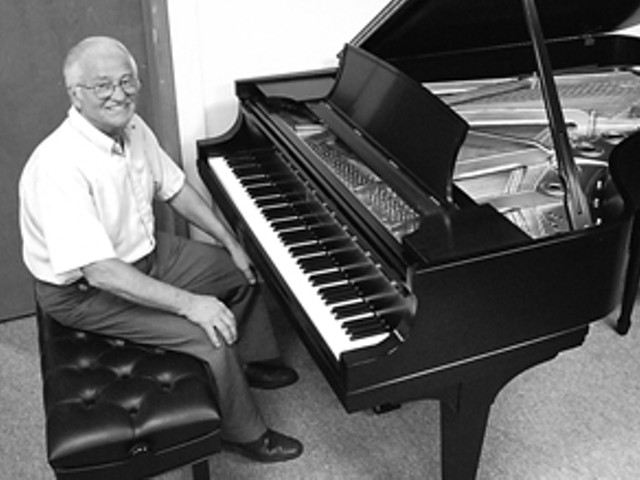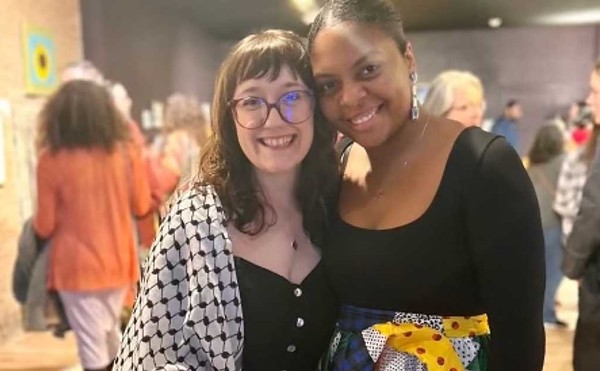On February 9, 1972, performance artist Chris Burden was invited to appear on a local Los Angeles arts TV program. He arrived, engaged in some debate and then held his point-counterpoint foil, art critic Phyllis Lutjeans, at knifepoint on live broadcast television for four hours, threatening her life should they cease transmission. The standoff ended, but not before Burden destroyed every shred of film from those four hours. He had brought along a photographer to document the event and thus did his become the only surviving side of the story save for what viewers had witnessed.
See, Burden seized the narrative from the medium to his own ends; he inserted himself into the conversation people have with broadcast media and blackmailed them emotionally, hopefully into a better understanding of their role as viewers.
More than 36 years later, performance artist George Walker Bush pulled his second homage to Burden's blackmail exercise. (His first was arguably his most bold: He commandeered each of the national broadcast networks and laid out such a deadpan performance of hysteria-inducing pseudofact that a nation went to war over a MacGuffin called "Yellow Cake.") A reluctant performer — one who took the stage only when properly cajoled by his peers — Bush injected himself into the network bloodstream on September 24, 2008 to convince the American public that it needed to pony up 700 billion dollars to corporations that had lost too much money trading in pretend investments — or face panic.
The reviewers all said it was clear he had lost some of his old panache, but the lessons he learned from Chris Burden were still true: 1) Conceal the objective truth of the situation (Burden may or may not have been in cahoots with Lutjeans); 2) Make your presentation as dramatic as possible; 3) Control the broadly accepted version of the story; 4) If you have to use a weapon, make sure you say what you've got to say before the authorities disarm you.
All this lies at the heart of the commentary on display in Broadcast, now showing at the Museum of Contemporary Art Detroit (MOCAD). Curated by Irene Hofmann, who's the executive director of the Contemporary Museum in Baltimore, the show features 13 works from the early '70s on by a group of international artists. The show includes single-channel monitor-based videos, installations, video-projection works, photography and interactive broadcasting projects. Burden's aforementioned "TV Hijack" is a centerpiece. Moreover, the first piece you experience is a video made by San Francisco guerrilla videographers TVTV in 1972 from the floor of the Nixon's 1972 inauguration. Using proto-home video technology, they were able to infect the proceedings. Their cameras allowed them to capture Mike Wallace off-guard, dismissing the very activist journalists he was speaking with as well as Julie Nixon extolling the virtues of her father's appeal among the Republican Youth (while the camera takes in a leering full body shot of the first daughter).
Thus begins a show that reminds us that in an age where such corporate-coined phrases as "narrowcasting," "niche marketing" and "cross-platform synergy" have become a fucked-up lingua franca, it wasn't always so. Before Stephen Colbert and Jon Stewart could turn a skewed irony on the machinations of the media, much groundwork had to be laid. Before YouTube had a proliferation of videos wherein Bill O'Reilly gets pwned by a guest, someone had to break through broadcasting's fourth wall.
So it is that Broadcast is an exhibit of artists including such progenitors as Burden and his progenitor Naim June Paik (whose spooky cut-and-paste audio and video collage "Video Tape Study #3" is presented here). It's also about Burden's descendents such as Dara Birnbaum. Her 1994 work, "Hostage," examines the role of the media in tragedy in a sequence of six TVs lined up in sequence, the middle four with plexiglass firing range targets mounted in front of the screen. The monitors each show footage of the 1977 Baader-Meinhof gang kindnap-murder from different worldwide networks. The end cap monitors feature Birnbaum's own reconstructed documentary about the events created using broadcast footage. The footage is interrupted as soon as you step into the line of TVs, asking implicitly, "just what are you watching anyway? And why?"
All of the artists represented here have actively injected themselves into the broadcast media — or, failing that, have actively chosen to rebroadcast content to their own ends, thus making the source material their own.
Perhaps none are more meta, or funny-thoughtful than Christian Jankowski's 1999 work "Telemistica." Jankowski was invited to participate in the prestigious Venice Biennale. His piece? "Telemistica." Italian television (apparently) was chock-full of TV psychics (cue cheesy graphics and over-the-top declarations of future wealth!) offering live call-in readings. So he learned some rudimentary Italian and called several of them, telling each he was an artist on the verge of creating and showing a very important piece. He'd ask such insecure questions as "Will I be successful?" or "Will they like it?" "Telemistica" is a video document of his inquiries. It's a möbius strip too guileless to be parody and too parodic to be guileless.
Speaking of guileless, in 1980, artists Doug Hall, Chip Lord and Jody Procter officially infiltrated Amarillo, Texas' KVII-TV as "artists-in-residence" for the piece "The Amarillo News Tapes." They got the news organization's full blessing to travel with the crews, write scripts and appear on-camera covering everything from the mundane (cattle auctions) to the tragic (the aftermath of a deadly tornado). The piece steps into the surreal when the boys get behind the desk with the anchors for a rehearsal run-through of the news and the trio botches/manipulates lines about the Masters golf tournament, an area lady's "plumbing problem" and the weather. Sublime and ridiculous, it's like a blueprint for Anchorman writ small.
Radio is the Sound Salvation
Finally, Broadcast has several stops along the way that take in that most anachronistic media — radio.
Most sober is artist collaborative neuroTransmitter's three-part commentary on media hegemony. Yes, commentary. But they participate, too. "Frequency Allocations" is a video documentary in which the filmmakers camp outside the offices of the nation's media conglomerates (truth.com style) and then display on-screen a truly comprehensive list of media properties owned by that conglomerate. It's both unsettling and meticulous in its detail of the information landscape that corporations control.
"12 Miles Out" is an elegant, wall-sized line drawing made of wire replicating the Radio Caroline, the original ship that was home to dissident political pirate radio broadcasts from international waters surrounding Great Britain in the 1960s and '70s. The wire drawing acts as a low-power antenna transmitting recordings of the original Radio Caroline broadcasts to a nearby receiver.
If neurotransmitter's pieces are reasoned and historical (even while being powerful), Gregory Green's "Radio Caroline" is an anarchic counterpoint. It's a real-live operating short-range radio station that's traveled from gallery to gallery for the past nearly 10 years with an open door programming policy — even if it only "broadcasts" for 100 yards from the museum. Set up under a tent in the middle of the exhibit, it's got bean bag chairs, turntables, CD player, 8-track and microphones. Guests can broadcast as they please, free from commercial and format constraints. For the Detroit stop, the DJ booth will play host to a who's who of Detroit music and artists including Danny Kroha, the UFO Factory folk and many others playing whatever the hell they want during museum hours. (Full disclosure: This writer will be spinning and spewing 11/11). It's a live wire of good old-fashioned radio weirdness that reminds one the Electrifying Mojo, Wolfman Jack and the Carter Family all used to drift in through the windows of our homes and deliver us to another world.
Broadcast is an intensely time-based exhibit, so give yourself an hour-and-a-half or so to take it all in and you'll be amply rewarded. The manipulation, irreverence and commentary of the pieces is not something you want to take in like Clark Griswold at the Grand Canyon.
The narratives we are either fed or bear witness to become the pieces of the puzzle that is our understanding of our world. And though the Internet has dramatically broadened that range, the tectonic plates that shake the tsunami of broad public opinion is still broadcast media. The pieces represented in Broadcast underscore not just the methods by which it is made, but the methods by which we can either resist or contextualize its madness.
Broadcast runs through Dec. 28. Museum of Contemporary Art Detroit, 4454 Woodward, Detroit;
313-832-6622.





